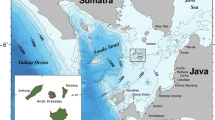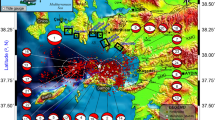Abstract
This article documents the near-field effects of the largest tsunami of 2012 (globally), which occurred following Canada’s second-largest recorded earthquake, on a thrust fault offshore western Haida Gwaii on October 28 (UTC). Despite a lack of reported damaging waves on the coast of British Columbia (largest amplitudes were recorded in Hawaii), three field surveys in the following weeks and months reveal that much of the remote unpopulated, uninstrumented coastline of western Haida Gwaii was impacted by significant tsunami waves that reached up to 13 m above the state of tide. Runup exceeded 3 m at sites spanning ~200 km of the coastline. Greatest impacts were apparent at the heads of narrow inlets and bays on western Moresby Island, where natural and manmade debris with a clear oceanward origin was found on the forest floor and caught in tree branches, inferring flow depths up to 2.5 m. Bays that see regular exposure to storm waves were generally less affected; at these sites a storm origin cannot be ruled out for the debris surveyed. Logs disturbed from their apparent former footprints on the forest floor at the head of Pocket Inlet provide evidence of complex runup, backwash and oblique flow patterns, as noted in other tsunamis. Discontinuous muddy sediments were found at a few sites; sedimentation was not proportional to runup. Lessons learned from our study of the impacts of the Haida Gwaii tsunami may prove useful to future post-tsunami and paleotsunami surveys, as well as tsunami hazard assessments.









Similar content being viewed by others
References
Abe, K. (1995), Estimate of tsunami run-up heights from earthquake magnitudes, In: Tsuchiya, Y., and Shuto, N. (eds.), Tsunami: progress in prediction, disaster prevention and warning, Advances in Technological Hazards Research, Kluwer Academic Publishers, Dordrecht, the Netherlands, 4:21–35.
Barrie, J.V., Conway, K.W., and Harris, P.T. (2013), The Queen Charlotte fault, British Columbia: seafloor anatomy of a transform fault and its influence on sediment processes, Geo-Mar Lett. 33:311–318, doi:10.1007/s00367-013-0333-3.
Borrero, J.C., Weiss, R., Okal, E.A., Hidayat, R., Suranto, Arcas, D., and Titov, V.V. (2009), The tsunami of 2007 September 12, Bengkulu province, Sumatra, Indonesia: post-tsunami field survey and numerical modelling, Geophys. J. Int. 178:180–194, doi:10.1111/j.1365-246X.2008.04058.x.
Bustin, A.M.M., Hyndman, R.D., Kao, H., and Cassidy, J.F. (2007), Evidence for underthrusting beneath the Queen Charlotte margin, from teleseismic receiver function analysis, Geophys. J. Int. 171:1198–1211, doi:10.1111/j.1365-246X.2007.03583.x.
Cassidy, J.F., Rogers, G.C., and Hyndman, R.D. (2014), An overview of the 28 October 2012 Mw 7.7 earthquake in Haida Gwaii, Canada: a tsunamigenic thrust event along a predominantly strike-slip margin, Pure Appl. Geophys., doi:10.1007/s00024-014-0775-1.
Clague, J.J., Bobrowsky, P.T., and Hutchinson, I. (2000), A review of geological records of large tsunamis at Vancouver Island, British Columbia, and implications for hazard, Quat. Sci. Rev. 19(9):849–863, doi:10.1016/S0277-3791(99)00101-8.
Dawson, A.G. (1994), Geomorphological effects of tsunami run-up and backwash, Geomorphology 10:83–94.
DeDontney, N., and Rice, J.R. (2012), Tsunami wave analysis and possibility of splay fault rupture during the 2004 Indian Ocean earthquake, Pure Appl. Geophys. 169(10):1707–1735, doi:10.1007/s00024-011-0438-4.
DeMets, C., Gordon, R.G., and Argus, D.F. (2010), Geologically current plate motions, Geophys. J. Int. 181:1–80, doi:10.1111/j.1365-246X.2009.04491.x.
Fine, I.V., Cherniawsky, J.Y., Thomson, R.E., Rabinovich, A.B., and Krassovski, M.V. (this volume), Observations and numerical modeling of the 2012 Haida Gwaii tsunami off the coast of British Columbia.
Fritz, H.M., Petroff, C.M., Catalán, P.A., Cienfuegos, R., Winckler, P., Kalligeris, N., Weiss, R., Barrientos, S.E., Meneses, G., Valderas-Bermejo, C., Ebeling, C., Papadopoulos, A., Contreras, M., Almar, R., Dominguez, J.C., and Synolakis, C.E. (2011), Field survey of the 27 February 2010 Chile tsunami, Pure Appl. Geophys. 168(11):1989–2010, doi:10.1007/s00024-011-0283-5.
González, F.I., Geist, E.L., Jaffe, B., Kânoğlu, U., Mofjeld, H., Synolakis, C.E., Titov, V.V., Arcas, D., Bellomo, D., Carlton, D., Horning, T., Johnson, J., Newman, J., Parsons, T., Peters, R., Peterson, C., Priest, G., Venturato, A., Weber, J., Wong, F., and Yalciner, A. (2009), Probabilistic tsunami hazard assessment at Seaside, Oregon, for near- and far-field seismic sources, J. Geophys. Res. 114(C11023), doi:10.1029/2008JC005132.
Goto, K., Chagué-Goff, C., Fujino, S., Goff, J., Jaffe, B., Nishimura, Y., Richmond, B., Sugawara, D., Szczuciński, W., Tappin, D.R., Witter, R.C., and Yulianto, E. (2011), New insights of tsunami hazard from the 2011 Tohoku-oki event, Mar. Geol. 290(1–4):46–50, doi:10.1016/j.margeo2011.10.004.
Hyndman, R.D., and Ellis, R.M. (1981), Queen Charlotte fault zone: microearthquakes from a temporary array of land stations and ocean bottom seismographs, Can. J. Earth Sci. 18(4):776–788, doi:10.1139/e81-071.
Jaffe, B.E., and Gelfenbaum, G. (2002), Using tsunami deposits to improve assessment of tsunami risk, In: Solutions to Coastal Disasters’02, Conference Proceedings, American Society of Civil Engineers, pp. 836–847.
James, T., Rogers, G., Cassidy, J., Dragert, H., Hyndman, R., Leonard, L., Nykolaishen, L., Riedel, M., Schmidt, M., and Wang, K. (2013), Field studies target 2012 Haida Gwaii earthquake, Eos Transactions, AGU, 94(22):197–198.
Leonard, L.J., Rogers, G.C., and Mazzotti, S. (2012a), A preliminary tsunami hazard assessment of the Canadian coastline, Geological Survey of Canada, Open File 7201, 126 p., doi:10.4095/292067.
Leonard, L., Bednarski, J., Fine, I., Cherniawsky, J., and Wright, C. (2012b), The Haida Gwaii tsunami of October 27, 2012, Risky Ground, Newsletter of the Centre for Natural Hazard Research, Simon Fraser University, Dec 21 2012—Winter edition, pp. 10–11.
Leonard, L.J., Rogers, G.C., and Mazzotti, S. (2014), Tsunami hazard assessment of Canada, Nat. Hazards 70(1):237–274, doi:10.1007/s11069-013-0809-5.
Mazzotti, S., Hyndman, R.D., Flück, P., Smith, A.J., and Schmidt, M. (2003), Distribution of the Pacific/North America motion in the Queen Charlotte Islands-S. Alaska plate boundary zone, Geophys. Res. Lett. 30(14):1762, doi:10.1029/2003GL017586.
National Geophysical Data Center/World Data System (NGDC/WDS) Global Historical Tsunami Database, Boulder, CO, USA. Available at: http://www.ngdc.noaa.gov/hazard/tsu_db.shtml (Last Accessed October 2013).
Razjigaeva, N.G., Ganzey, L.A., Grebennikova, T.A., Ivanova, E.D., Kharlamov, A.A., Kaistrenko, V.M., and Shishkin, A.A. (2013) Coastal sedimentation associated with the Tohoku tsunami of 11 March 2011 in South Kuril Islands, NW Pacific Ocean, Pure Appl. Geophys. 170(6–8):1081–1102.
Rice, A., 2012, Debris possibly from Japanese tsunami floating up Strait of Juan de Fuca, Peninsula Daily News, May 15 2012. Available at http://www.peninsuladailynews.com/article/20120515/news/305159993/debris-possibly-from-japanese-tsunami-floating-up-strait-of-juan-de-fuca.
Rohr, K.M.M., Scheidhauer, M., and Trehu, A.M. (2000), Transpression between two warm mafic plates: the Queen Charlotte fault revisited, J. Geophys. Res. 105(B4):8147–8172, doi:10.1029/1999JB900403.
Szczuciński, W. (2012), The post-depositional changes of the onshore 2004 tsunami deposits on the Andaman Sea coast of Thailand, Nat. Hazards 60(1):115–133, doi:10.1007/s11069-011-9956-8.
Suleimani, E., Nicolsky, D.J., Haeussler, P.J., and Hansen, R. (2011), Combined effects of tectonic and landslide-generated tsunami runup at Seward, Alaska during the Mw 9.2 1964 earthquake, Pure Appl. Geophys. 168:1053–1074.
Szeliga, W. (2013), 2012 Haida Gwaii quake: insight into Cascadia’s subduction extent, Eos Trans., AGU 94(9):85–86.
Acknowledgments
The manuscript was improved by useful comments from two anonymous reviewers and Alexander Rabinovich. Isaac Fine and Josef Cherniawsky provided us with preliminary tsunami models that were invaluable to our field survey; subsequent discussions with them were also useful in the preparation of this paper. Peter Haeussler and Rob Witter (USGS) and Ben Rahier provided important observations leading us to expand our survey and our findings. We thank many colleagues at the Pacific Geoscience Centre who provided us with field equipment as well as logistical and other support—including Mike Schmidt, Lisa Nykolaishen, Scott Dallimore, Roger MacLeod, Michelle Côté, Joe Henton, Thomas James, John Cassidy, and Garry Rogers. We also thank Matt Barker (Department of Fisheries and Oceans) for the loan of (and training on) the Total Station. We thank Cindy Wright, Lisa Nykolaishen and Brian Schofield for assistance in the field. Finally, the post-tsunami survey would not have been possible without the permission and support of Parks Canada and the Haida Nation. This is Earth Sciences Sector contribution No. 20130462.
Author information
Authors and Affiliations
Corresponding author
Rights and permissions
About this article
Cite this article
Leonard, L.J., Bednarski, J.M. Field Survey Following the 28 October 2012 Haida Gwaii Tsunami. Pure Appl. Geophys. 171, 3467–3482 (2014). https://doi.org/10.1007/s00024-014-0792-0
Received:
Revised:
Accepted:
Published:
Issue Date:
DOI: https://doi.org/10.1007/s00024-014-0792-0




